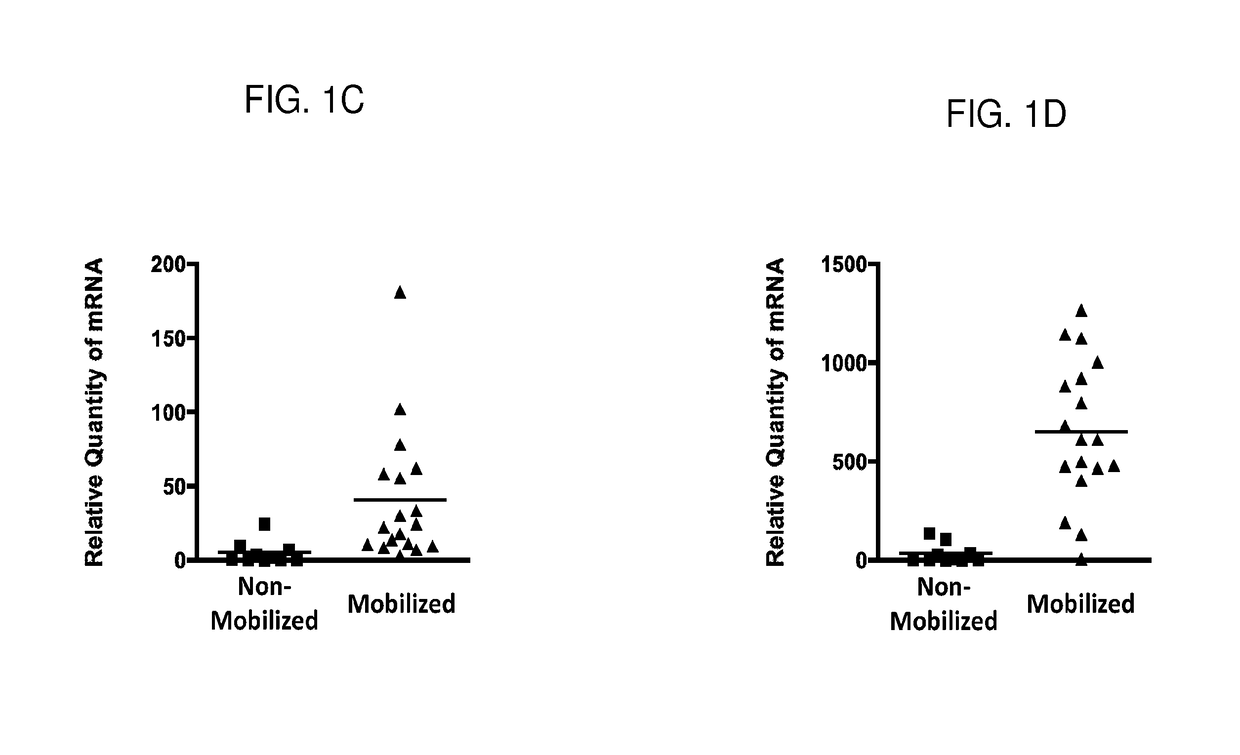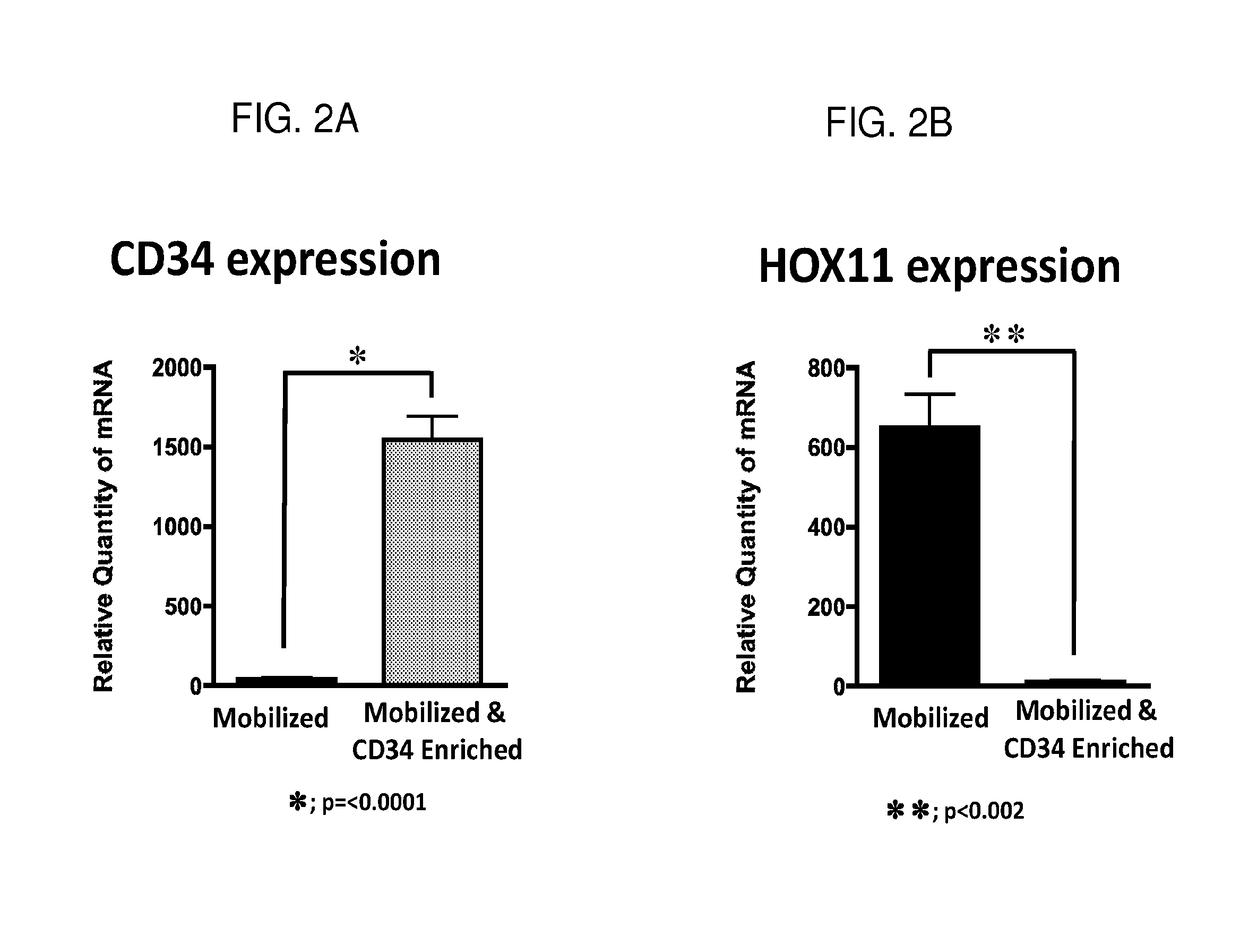Compositions enriched for hox11+ stem cells and methods of preparing the same
a technology of stem cells and compositions, applied in the field of compositions enriched for hox11 + stem cells, can solve the problems of reducing and generating superior clinical benefits, so as to increase the number of stem cells and enhance the mobilization of stem cells
- Summary
- Abstract
- Description
- Claims
- Application Information
AI Technical Summary
Benefits of technology
Problems solved by technology
Method used
Image
Examples
example 1
n of Hox11+ Stem Cells from Mobilized Peripheral Blood
Materials
[0101]All −70° C. frozen human peripheral blood cell samples used for this study were either from the Core Center of Excellence in Hematology (CCEH) at the Fred Hutchison Cancer Research Center or from Massachusetts General Hospital (MGH). These peripheral blood samples were obtained from donors not treated (non-mobilized samples) or treated with recombinant G-CSF (mobilized samples). Additional samples include peripheral blood samples from G-CSF treated donors that were further enriched for CD34+ stem cells. The non-mobilized, mobilized, and CD34+ stem cell enriched samples were obtained following human consent protocol 985.03-2 from Fred Hutchison Cancer Research Center. Additional fresh peripheral blood lymphocytes (PBLs) that were used to standardize the mRNA expressions of the frozen PBLs samples were obtained following human consent protocol MGH-2001P001379 from MGH, which involved the obligatory informed consent o...
example 2
ilized Peripheral Blood Contains CD34+ Stem Cells and Hox11 Stem Cells
[0105]Ten human donors not treated with G-CSF provided non-mobilized peripheral blood samples and eighteen donors treated with G-CSF provided mobilized peripheral blood samples. All human donors were healthy and without underlying malignancies. Peripheral blood lymphocytes (PBLs) were isolated from either non-mobilized or mobilized peripheral blood samples using leukapheresis.
[0106]Following the method described above, the expressions of CD34 and Hox11 genes were studied using quantitative mRNA. The data in FIGS. 1 (A) and (C) show that CD34 mRNA expression was exclusively found in PBLs isolated from mobilized peripheral blood samples that were obtained from donors treated with G-CSF (p=0.02). CD34+ stem cells are generally not observed in PBLs isolated from non-mobilized peripheral blood samples that were obtained from donors not treated with G-CSF. The data in these samples confirm the benefit of G-CSF in mobili...
example 3
m Cells and Hox11+ Stem Cells in G-CSF Mobilized Peripheral Blood are Distinct Stem Cell Populations
[0108]To ensure that the CD34+ stem cells and the Hox11+ stem cells detected in the PBLs of mobilized peripheral blood (Example 2) are indeed two different populations of stem cells and not caused by aberrant expression of Hox11 gene by CD34+ stem cells, PBLs obtained from mobilized peripheral blood samples were specifically enriched for CD34+ stem cells using positive magnetic bead enrichment. Using quantitative mRNA expression analysis, data in FIGS. 2 (A) and (C) show the expected, strong expression of CD34 in the G-CSF mobilized, CD34+ stem cell enriched PBLs (p=<0.0001). Additionally, data in FIGS. 2 (B) and (D) effectively demonstrate the lack of Hox11 expression in the same G-CSF mobilized, CD34+ stem cell enriched PBLs (p<0.002). Therefore, FIG. 2 shows that G-CSF treatment can mobilize at least two distinct populations of stem cells, CD34+ stem cells and Hox11+ stem cells.
PUM
| Property | Measurement | Unit |
|---|---|---|
| time | aaaaa | aaaaa |
| volume | aaaaa | aaaaa |
| volume | aaaaa | aaaaa |
Abstract
Description
Claims
Application Information
 Login to View More
Login to View More - R&D
- Intellectual Property
- Life Sciences
- Materials
- Tech Scout
- Unparalleled Data Quality
- Higher Quality Content
- 60% Fewer Hallucinations
Browse by: Latest US Patents, China's latest patents, Technical Efficacy Thesaurus, Application Domain, Technology Topic, Popular Technical Reports.
© 2025 PatSnap. All rights reserved.Legal|Privacy policy|Modern Slavery Act Transparency Statement|Sitemap|About US| Contact US: help@patsnap.com



